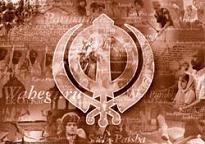
The Unique Sacrifice
Guru Tegh Bahadur had assured the Brahmans by saying: "We shall be seeing him (the king) after the rainy season." The rainy season was spent by the Guru at Saifabad where the Muslim chief Nawab Saifuddin served the Guru with great reverence and received His blessings. The Emperor was in Agra so the Master Saviour reached Agra instead of going to Delhi.
Guru Tegh Bahadur accompanied by five Sikhs Bhai Mati Das, Bhai Dyal Das, Bhai Sati Das, Bhai Gurditta and Bhai Uda, stayed in a garden in the outskirts of Agra. The Guru, decided to disclose His identity in a novel and undaunted manner. He sent a shepherd boy to the city to fetch some sweets for the party and gave him a diamond ring and a Kashmiri Shawl. The shepherd. on presenting the ring in exchange for the purchases, was suspected ill having stolen these items and was handed over to the police. On his being questioned the boy informed them that he had been sent by a great King staying in the garden. and that he was only a messenger.
The police and military authorities at once knew that it must be Guru Tegh Bahadur as they had the information that He was coming to see the Emperor. Since the Emperor had already left for Delhi, the authorities took charge of the party and they were escorted to Delhi under a strong contingent of 1,700 cavalry men. The shepherd boy received the Guru's blessings and the valuable items.
Another reason for Guru Tegh Bahadur visiting Agra is that an elderly Sikh lady was meditating day and night on the holy Nam and was always seeking the Guru's darshan (audience). She had prepared a hand-spun garment for the Guru and wished that the Guru should come personally and wear the same. As such Guru Tegh Bahadur was bound by the love of the disciple and visited her, received the offering, and blessed her. There now stands Gurdwara Mai Than at this place.
On arrival in Delhi the Guru was kept under house arrest. The house
where the Guru was kept was believed to have been haunted and was commonly
known as "Bhootan-di-Haveli" (House of Ghosts).*
* The authors were told by the learned Gyanis that the
present building of the Majestic Cinema opposite the Gurdwara Sis Ganj
Sahib is the same site where the said haunted haveli stood. It is a pity
that the Sikhs did not care to preserve this haveli and many other sites
like it.
Guru Tegh Bahadur held three meetings with the Emperor, Aurangzeb. During the course of the discussions and the arguments that ensued in these conferences. Aurangzeb tried to justify his actions to crush the infidels, because according to him the Hindus were destined to be thrown into hell if they did not accept Islam. He pretended to be carrying out this policy on the orders of the God Almighty and was serving as a saviour for these condemned people and further argued that the only way for them to gain admission to the heavens and to avoid hell was to embrace Islam. He advanced the futile argument that only the muslims were believers in God and only they were acceptable to God. The despot who was blinded by power and pride did not realise that he was trying to persuade the Divine Manifest - the very source of Light and Knowledge. Who had already in His First Form as Guru Nanak told his ancestors at Mecca itself that both the Hindus and the Muslims will suffer without good deeds, and the good deeds were based on love and service of the whole mankind.
Guru Tegh Bahadur ji in His reply told the Emperor of Delhi: "All men are created by God and therefore must be free to worship in any manner they like." It would be worth noting that the Sikhs are as much against idol worship as are the Muslims. Therefore, ideologically Guru Tegh Bahadur and Aurangzeb were much nearer to each other, than the Hindus - whose cause the Guru was espousing. It should be clear that the Guru was defending an ideology in which He Himself did not believe. This is why His sacrifice was so great and so unique. His son the Great Guru Gobind Singh, has described this supreme act in His autobiography as follows:-
"The Lord protected their frontal mark and sacred thread; And performed a supremely heroic act in this age of Ignorance.Guru Gobind Singh ji has clearly stated the causes which led to the martyrdom of his Father-Guru. He has in a beautiful poetic style narrated to us the events of that time. The following points are worth noting regarding the martyrdom of Sri Guru Tegh Bahadur.
To uphold righteousness, so supreme an act did He perform; He gave His head, but did not utter a word of sorrow.
For the sake of righteousness. He did this great heroic deed; He laid down His life but not the principles.
Miracles are a cheap way of fooling people; True Prophets of God are ashamed of displaying occult powers.
Guru Tegh Bahadur broke His earthly vase on the head of the Emperor of Delhi; And went to the Abode of God.
No one has ever done such a unique deed as did Guru Tegh Bahadur.
On the Ascent of Guru Tegh Bahadur, the whole world went into mourning.
Alas! Alas! rose the wailing cries from the earth; While the shouts of Glory! Glory! resounded the heavens."
(i) The Guru made this supreme sacrifice in order to protect the Hindus "frontal mark and sacred thread." This clearly shows that the Guru was sacrificing his life for the cause of the others (Hindus).
(ii) That "No one has ever done such a unique deed as did Guru Tegh Bahadur." That is, no one in the history of mankind has sacrificed his life to protect the freedom of worship of others.
(iii) That the Guru performed this great heroic deed "for the sake of righteousness." Therefore it would be unwise to give any other cause for his martyrdom.
(iv) That the Guru "laid down his life, but not the principles" - SIS DIYA PAR SIRR NA DYA. i.e. the Guru was offered a choice between accepting Islam or death; 'and that he willingly accepted the latter.
(v) That the Guru did not show any miracles which He regarded were "a cheap way of fooling people," i.e. the Guru had another choice-that of showing miracles. The Guru again chose death rather than showing miracles, which "the true prophets of God are ashamed of."
(vi) That "Guru Tegh Bahadur broke his earthly vase on the head of the Emperor of Delhi." i.e. Aurangzeb must have been at Delhi at the time of the martyrdom and is directly responsible for it.
We have said earlier in this chapter that the Guru was defending an ideology in which He himself did not believe. This might appear to be a paradox at first sight. But it is no more a paradox once we look at the Gurbani of Guru Nanak ji Which was composed by Him at the time of Babur's invasion at Eminabad, in which He said:
"If a strong power attacks another strong power, No one would grieve, none would complain; But when fierce tigers prey on helpless cattle, Thou herdsman must answer for it."Guru Tegh Bahadur ji as the incarnation of God Almighty was acting as the "Herdsman" now. The Hindus who were helpless were like cattle and the Muslim rulers had taken the shape of fierce tigers. Otherwise, the Guru had nothing against the Muslims. He was "neither a Hindu nor a Mussalman." Later, Guru Gobind Singh took on the role of "herdsman" and fought the Muslims on several occasions-not because they were Muslims, but because they were oppressors of that time. Similarly, he defended the Hindus, not because he loved them more than the Muslims - some of whom were equally dear to him; but because they happened to be the "harmless sheep" of the time. This spirit of "fair play" was entrusted to the Khalsa by Guru Gobind Singh when he created Khalsa Order in 1699 A.D. The Guru described the Kha1sa as being the "God's very own." So, both Guru Gobind Singh ji and his Khalsa on all occasions fought against the tyrants and not against the Muslims; similarly they fought to defend the downtrodden and not to defend the Hindus. This was the mission of Guru Nanak-Guru Gobind Singh, to which the martyrdom of Guru Tegh Bahadur made an invaluable contribution.
During the discussions which the Great Guru had with Aurangzeb, the Emperor told the Guru that it was his uttermost desire to see all Hindustan embrace Islam, and that it was with this intention that he had imposed Jazia on his non-muslim subjects; had ordered the demolition of their temples and destruction of their scriptures (Vedas), and had ordered them to embrace Islam or face death. The Emperor requested the Guru to embrace Islam, for he knew that Guru Nanak's House was equally against idol worship. The Emperor was not unaware of the tenets of Guru Nanak's religion.
The Emperor knew not that it was not in the nature of the True Prophets of God like Guru Tegh Bahadur ji to give up their ideology in order to save their life. Such pure souls remain unmoved when made to sit on hot iron plates or when seated on freezing ice-slabs. Moreover, it is clear from the writings of Guru Tegh Bahadur that he regarded the very nature of this world to be transitory. His philosophy can be summarized in a few shlokas (couplets) that were composed by the Guru at Delhi:
"He who is unaffected by praise or blame or honour or ignominy, with whom gold and iron are alike; Sayeth Nanak, listen O Mind, he is liberated."
"He who is not moved by joy or sorrow, and to whom friend and foe are alike; Sayeth Nanak, listen O Mind, he is liberated."
"He who inspireth no fear and who hath no fear of others; Listen O Mind, sayeth Nanak, he is possessed of divine knowledge."
"The world is evanescent like a dream or a vision; Sayeth Nanak, there is nothing real in it but God."
"As bubbles are constantly formed on the surface of water only to disappear; Sayeth Nanak, O friend, such is the process of world formation."
"Rama passed away. Ravan also passed away with his large family; Sayeth Nanak, nothing is permanent, the world is like a dream."
"That which is born shall be destroyed today, tomorrow or the day after; Nanak sing the Lord's praises, and give up all entanglement (attachment)."
The True Guru who did not inspire fear into anybody nor did he fear
anybody, was not in the least bit hesitant of sacrificing his self for
the great ideas of Guru Nanak. He merely regarded the world as a dream
or a vision in which nothing was real except God, with Whom He was One.
It is only egotists who regard this world as permanent and thus fall prey
to worldly temptations. Pure souls do not go for material gains, for they
regard them as transitory.
The Guru told Aurangzeb, the Emperor, that he was committing these crimes and atrocities to satisfy his own selfish ends and that he was covering them up under the cloak of religion. The Guru told him that conversion could not be carried out by force, threats or bribes. Conversion depends on the change of heart. Why did not the uncle of the prophet Mohammed become a convert to the faith of Islam? "You say your religion does not allow idol worship in any form. Then Where is the justification to enjoin the kind of worship to be offered to the black stone of Kaaba?"
The Emperor then enquired of the Guru if He had ever had an occasion to show swordsmanship and justify his name Tegh Bahadur (Master of the Sword). Diwan Matidas who was standing by the Guru and who had a good command of the Persian language at once interrupted and said that the Guru and His Father, the Great Warrior-Prophet Guru Hargobind Sahib gave a crushing defeat to the Imperial forces of Jehangir and Shahjehan, not once but four times. The Guru then stopped Matidas and told the Emperor that He shall show such a mastery of the sword, the like of which the Emperor may never have seen before.
At the end of these discussions the Emperor looked tired and much confused.
He gave the Guru three options:
(i) To embrace Islam as His religion and receive the highest honours
in his court. Or
(ii) To show Karamaat (miracles) which the Muslims regard as the fundamental
characteristic of a true prophet; or
(iii) To accept death.
The Guru declined to accept Islam or to show any miracles. It is appropriate to quote a passage from Raja Sir Daljit Singh's book on Guru Tegh Bahadur. He says that the chief guard of the prison came up to Guru ji and said: "I know you are indeed a great spiritual and holy person favoured by God most high. I see miracles taking place every day here in this prison. Why do you not perform some such great deed in the presence of the Emperor so that he may release you and torture you no more?" The Master replied: "My friend, Karamaat means favour or kindness of God. His favour is not for the purpose of show, like a juggler. Such misuse of His blessings brings His wrath."
So, Guru Tegh Bahadur ji declined to embrace Islam or to show miracles but willingly accepted the third offer - that of death.
During His stay at Delhi the Guru was in constant touch with his family who were at Anandpur Sahib. The Guru was particularly interested to know as to whether His son, who was barely nine years of age, would be able to shoulder the heavy responsibilities of the throne of Guru Nanak; especially under the tyrannic rule of Aurangzeb. Therefore, in order to test young Gobind Rai the Guru, in one couplet, described the pathetic situation of the oppressed people of India. The couplet goes thus:-
"All human power has failed,Young Gobind Rai who was soon to be the tenth Guru of the Sikhs, composed the following couplet at Anandpur Sahib and sent it to his Father-Guru at Delhi through a messenger:-
Humanity groans in chains;
Moral efforts are of no avail;
Lord, save them O save
With Thy Merciful aid,
As Thou didst save
The drowning legendary elephant that prayed!"
"Power is secured, bondage is no more,Guru Tegh Bahadur ji was very pleased to receive such a courageous reply from His young son. Moreover. it was a reply which was comparable to the philosophy of Guru Nanak in every way. The Guru prophesied that His son would liberate the downtrodden Indians from their age-old bondage of slavery, caste system and rituals.
Every effort is crowned with success;
Everything is in Thy hands, Nanak,
Be Thou my refuge."
Guru Tegh Bahadur ji gave Bhai Gurditta five paisas and a coconut and bowed towards Anandpur Sahib. Thus crowning Gobind Rai to be the Tenth Guru of the Sikhs. The holy spirit of Guru Nanak was transfused into Guru Gobind Singh as a candle is lit from another candle. Guru Tegh Bahadur then asked Bhai Gurditta and Bhai Uda to leave the prison. The presence of Bhai Gurditta at Anandpur Sahib was necessary at the Investiture ceremony of Guru Gobind Rai, since it was customary for Baba Budha jee, or after him, his offspring's to anoint the new Guru. On the other hand. Bhai Uda was asked to stay in Delhi since he was to perform valuable services after the great martyrdom.
Next morning when the prison authorities informed the Emperor that two of the disciples of Guru Tegh Bahadur were missing, he was enraged and asked the Guru to be produced before him. The Emperor asked the Guru as to why two of His men had escaped. The Guru told the Emperor in reply that his only concern was with the Guru and that His Sikhs had accompanied Him to Delhi only to serve Him. Therefore, they could leave as and when they wished. The Emperor then ordered that the Guru be locked in an iron cage.
On seeing the unbearable tortures which His Master was enduring. Matidas came before Him with folded hands and said: "O True King. I cannot live to see you suffer such brutal tortures."
The Guru told Matidas that His suffering was necessary to put a halt to the atrocities committed by the king. Matidas kowtowed before the Guru in reverence and said that he too shall sacrifice his life, thus playing his part in the sacred cause.
This conversation was overheard by the authorities and was reported to the Emperor. Next day Aurangzeb ordered that Matidas should either embrace Islam or be executed. Matidas, naturally refused to accept Islam as his faith. He was ordered to be sawn alive. On hearing these orders Bhai Matidas' face became red with joy. He touched the holy feet of the Guru and sought the Guru's blessings.
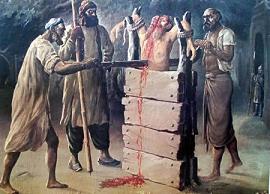 The
great Saint Matidas then handed himself to the executioner. He was to be
bound between two pillars and cut in twain. When the saw was applied to
his head, he calmly and serenely uttered: "Ik Onkar" and started to recite
the "Japji" (Sikh Morning Prayer}. It is said that the body was cut in
twain, but the Japji was all along heard being repeated by him, and it
continued to be repeated till all was over. Thus the first sacrifice was
completed. At the place where Bhai Matidas was executed there now stands
in his memory the famous Fountain of Chadni Chowk, Delhi. The fountain
symbolises the blood of Bhai Matidas which once oozed out from his pliant
body.
The
great Saint Matidas then handed himself to the executioner. He was to be
bound between two pillars and cut in twain. When the saw was applied to
his head, he calmly and serenely uttered: "Ik Onkar" and started to recite
the "Japji" (Sikh Morning Prayer}. It is said that the body was cut in
twain, but the Japji was all along heard being repeated by him, and it
continued to be repeated till all was over. Thus the first sacrifice was
completed. At the place where Bhai Matidas was executed there now stands
in his memory the famous Fountain of Chadni Chowk, Delhi. The fountain
symbolises the blood of Bhai Matidas which once oozed out from his pliant
body.
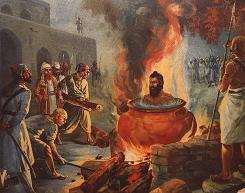
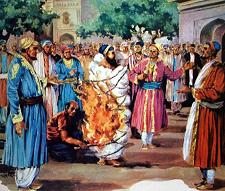 Next,
Bhai Dyal Das and Bhai Sati Das were executed. Bhai Dyal Das's hands and
feet were tied firmly and he was thrown into a cauldron of boiling water.
Not a sign of grief was uttered by this beloved disciple of the Guru. Bhai
Sati Das, who was the younger brother of Mati Das, was ordered to be torn
into pieces, and this cruel order was complied with by the authorities.
It would be of interest to note that Bhai Dyal Das had eleven brothers,
all of whom, except Amar Chand, who died in infancy, died the death of
martyrs. Their names are as follows:-
Next,
Bhai Dyal Das and Bhai Sati Das were executed. Bhai Dyal Das's hands and
feet were tied firmly and he was thrown into a cauldron of boiling water.
Not a sign of grief was uttered by this beloved disciple of the Guru. Bhai
Sati Das, who was the younger brother of Mati Das, was ordered to be torn
into pieces, and this cruel order was complied with by the authorities.
It would be of interest to note that Bhai Dyal Das had eleven brothers,
all of whom, except Amar Chand, who died in infancy, died the death of
martyrs. Their names are as follows:-
| 1. Bhai Jetta | 2. Bhai Mani Singh |
| 3. Bhai Dan Singh | 4 Bhai Man Singh |
| 5. Bhai Rup Singh | 6. Bhai Jagat Singh |
| 7. Bhai Sohan Chand | 8. Bhai Lehna Singh |
| 9. Bhai Rai Singh | 10. Bhai Hathi Chand |
Guru Tegh Bahadur was made to watch the martyrdom of His beloved disciples. It was hoped by the Emperor that this might act as a deterrent, and so the Guru may decide to embrace Islam, after all. The Guru, on the other hand, remained unmoved and unconcerned. He was happy that three of His dearest disciples had played their little part to fulfil the great mission of Guru Nanak and paved the way for hundreds of the Khalsa martyrs who later followed their footsteps.
The tyrant Emperor then issued his final orders that Sri Guru Tegh Bahadur Sahib should be beheaded in Chandni Chowk which was the central market place of Delhi, then as it is now.
Next morning, a large crowd gathered at Chandni Chowk to see the unique sacrifice of a Pir, whom all Hindus acknowledged to be their spiritual leader. Sri Guru Tegh Bahadur took His bath in a nearby well and recited the holy hymns. This well still exists and is situated near the back entrance to Gurdwara Sis Ganj. The Guru was then seated on a platform which had been erected for this occasion under a banyan tree, Qazi Abul Wahhab Borah then read the "fatwa." The executioner Jalaluddin of Samana stood nearby.
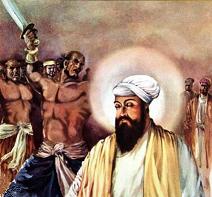 The
Guru requested Jalaluddin to strike the blow when He had finished the recitation
of "Japji Sahib" (Sikh morning prayer) and when He bowed in reverence at
the end. Accordingly, Jalaluddin struck the blow. The holy head flew into
the lap of Bhai Jaita, who was standing nearby. He moved away swiftly towards
Anandpur Sahib as ordained by his Master. The World had seen a miracle
and the Mastery of the Sword at Delhi the like of which they had never
seen before. The Guru performed this "supremely heroic act to uphold righteousness"
on Thursday, the eleventh day of November 1675 A.D. or 1732 Bikrami a few
minutes after the clock had struck nine. It is recorded in history that
the martyrdom took place a little after sunrise. The authors were told
by the late Mahant Gurbakhsh Singh of Gurdwara Rakab Ganj Sahib that his
grandmother, who had met S. Baghel Singh at Delhi had told him that the
exact time of this martyrdom was 9.12 a.m. At the place where Guru Tegh
Bahadur ji 'was martyred there now stands the magnificent shrine Gurdwara
Sis Ganj Sahib.
The
Guru requested Jalaluddin to strike the blow when He had finished the recitation
of "Japji Sahib" (Sikh morning prayer) and when He bowed in reverence at
the end. Accordingly, Jalaluddin struck the blow. The holy head flew into
the lap of Bhai Jaita, who was standing nearby. He moved away swiftly towards
Anandpur Sahib as ordained by his Master. The World had seen a miracle
and the Mastery of the Sword at Delhi the like of which they had never
seen before. The Guru performed this "supremely heroic act to uphold righteousness"
on Thursday, the eleventh day of November 1675 A.D. or 1732 Bikrami a few
minutes after the clock had struck nine. It is recorded in history that
the martyrdom took place a little after sunrise. The authors were told
by the late Mahant Gurbakhsh Singh of Gurdwara Rakab Ganj Sahib that his
grandmother, who had met S. Baghel Singh at Delhi had told him that the
exact time of this martyrdom was 9.12 a.m. At the place where Guru Tegh
Bahadur ji 'was martyred there now stands the magnificent shrine Gurdwara
Sis Ganj Sahib.
The Emperor had it announced in the Capital that the headless body of the "Pir of the Hindus" lies in Chandni Chowk. "He who wishes to cremate it may come forward and do so." At the same time he imposed a heavy guard around that area so that no Sikh or Hindu may come near it.
There was mourning all around Delhi. For the Hindus, Guru Tegh Bahadur ji was their last hope; their gods had told them so. Even some God-fearing Muslims mourned and said that the Sultan had "not done well." They knew not that from each drop of the holy blood that fell on this day, there were to be born hundreds of thousands of Sikh martyrs, who would bring this mighty Moghul Empire on to its toes.
The Guru had shown us that to defend one's principles one must be ready to give up one's life.
This has ever since been the fundamental principle of Sikhism. "To accept death first, and to give up the false hope of life." This was the spirit with which Baba Banda Singh Bahadur, Sardar Jassa Singh Ahluwalia, Baba Deep Singh, Akali Phulla Singh and Sardar Hari Singh Nalwa fought. This was the philosophy which had the saffron flag of the Khalsa flying all over the Punjab within one generation after Guru Gobind Singh ji's ascent.
On that unhappy day heavy clouds moved over Delhi and soon heavy dust storms and rain followed. It looked as though even the nature had gone into mourning. Under such weather conditions, most of the guards had now dispersed, and those who were there became ineffective. In the afternoon Lakhi Shah - a Sikh of the "Vanjarah" tribe moved towards Chandni Chowk at a great speed along with his caravan of bullock carts. Lakhi Shah was an intimate devotee of Guru Tegh Bahadur ji. He at once lifted the holy body and wrapped it under the bales of cotton that he was carrying. He then dashed towards his residence at Rakabganj. At Rakabganj, a whole locality of "Vanjarahs" lived. Lakhi Shah reached there at about midnight. He knew that he did not have much time at his disposal since the Imperial forces would soon be after him. So, he asked his family and neighbours to move out of their huts quickly. He then set fire to the whole village so that it appeared as if the whole place was on fire and not as though one body was being cremated. Next morning Lakhi Shah had the ashes of Guru Tegh Bahadur ji put into two urns and buried at the same place where His body had been cremated. At this place now stands the historic shrine of Rakabganj Sahib only a few hundred yards away from the Houses of Parliament of the Republic of India. The first building was built by Sardar Baghel Singh when he invaded Delhi in the 18th century. The present magnificent marble building has only recently been completed.
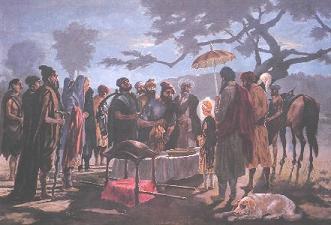 On
the other hand, the holy head of the Guru was carried to Anandpur Sahib
via Ambala and Rupar. Just before Bhai Jaita reached Anandpur Sahib, a
whole procession of Sikhs led by Guru Gobind Rai came towards him. Bhai
Jaita then kowtowed before the young Guru and presented before Him the
holy head of His Father-Guru. The Guru then embraced him and said: "Rangrete
Guru ke Bete." (Bhai Jaita, you and your clan are beloved sons of the Guru).
Guru Gobind Rai then had a pyre of Sandal- wood prepared and after reciting
the preamble to Japji Sahib and Sohilla* set fire
to it. At the place where the head of Guru Tegh Bahadur ji was cremated
there now stands the historic shrine of Gurdwara Sis Ganj Sahib.
On
the other hand, the holy head of the Guru was carried to Anandpur Sahib
via Ambala and Rupar. Just before Bhai Jaita reached Anandpur Sahib, a
whole procession of Sikhs led by Guru Gobind Rai came towards him. Bhai
Jaita then kowtowed before the young Guru and presented before Him the
holy head of His Father-Guru. The Guru then embraced him and said: "Rangrete
Guru ke Bete." (Bhai Jaita, you and your clan are beloved sons of the Guru).
Guru Gobind Rai then had a pyre of Sandal- wood prepared and after reciting
the preamble to Japji Sahib and Sohilla* set fire
to it. At the place where the head of Guru Tegh Bahadur ji was cremated
there now stands the historic shrine of Gurdwara Sis Ganj Sahib.
* Last prayer of the Sikhs before going to bed
Aurangzeb, the Emperor, became very unsettled ever since the day of Martyrdom of Guru Tegh Bahadur ji; his soul having been shaken by this heinous sin. It is said that he saw before him the spirit of Bhai Matidas every night and that he became extremely frightened of it. Outwardly, his Qazis, Mullahs and other Ministers tried to flatter him and justified his actions under Islamic law. But only he knew his inner plight. Soon the trouble in the Deccan (South India) started which later proved fatal for him. Soon the time came for the Emperor to die a miserab1e death at Aurangabad. He who had once forgotten his end had now been "grinded under the molars of death." It would be of interest to note that just as the two parts of the body of Sri Guru Tegh Bahadur ji were cremated separately at two different places, so too were two graves constructed to commemorate the death of Aurangzeb - one at Ahmed Nagar and the other at Aurangabad. The difference, however, is that while thousands pay homage at the shrines of Guru Tegh Bahadur every day, only dogs and owls acquaint the tombs of Aurangzeb.
"The Name remained, the Saints remained, and God remained.
Sayeth Nanak, in this world some rare one recited the mantra of the Guru."
(Guru Tegh Bahadur Sahib)
| Previous Chapter - The Hindu Religion seeks Protection |